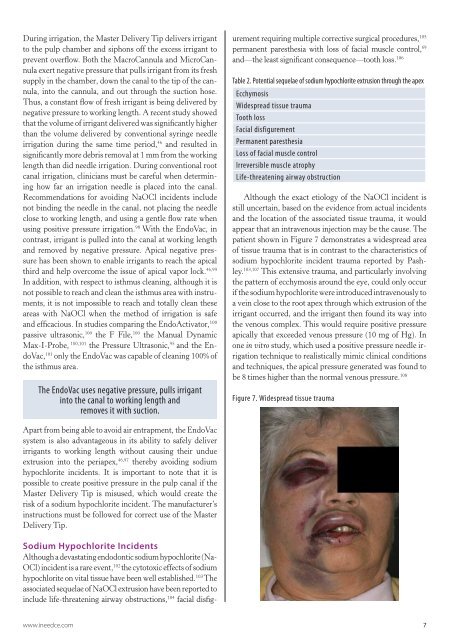Safety and Efficacy Considerations in Endodontic ... - IneedCE.com
Safety and Efficacy Considerations in Endodontic ... - IneedCE.com
Safety and Efficacy Considerations in Endodontic ... - IneedCE.com
You also want an ePaper? Increase the reach of your titles
YUMPU automatically turns print PDFs into web optimized ePapers that Google loves.
Dur<strong>in</strong>g irrigation, the Master Delivery Tip delivers irrigant<br />
to the pulp chamber <strong>and</strong> siphons off the excess irrigant to<br />
prevent overflow. Both the MacroCannula <strong>and</strong> MicroCannula<br />
exert negative pressure that pulls irrigant from its fresh<br />
supply <strong>in</strong> the chamber, down the canal to the tip of the cannula,<br />
<strong>in</strong>to the cannula, <strong>and</strong> out through the suction hose.<br />
Thus, a constant flow of fresh irrigant is be<strong>in</strong>g delivered by<br />
negative pressure to work<strong>in</strong>g length. A recent study showed<br />
that the volume of irrigant delivered was significantly higher<br />
than the volume delivered by conventional syr<strong>in</strong>ge needle<br />
irrigation dur<strong>in</strong>g the same time period, 46 <strong>and</strong> resulted <strong>in</strong><br />
significantly more debris removal at 1 mm from the work<strong>in</strong>g<br />
length than did needle irrigation. Dur<strong>in</strong>g conventional root<br />
canal irrigation, cl<strong>in</strong>icians must be careful when determ<strong>in</strong><strong>in</strong>g<br />
how far an irrigation needle is placed <strong>in</strong>to the canal.<br />
Re<strong>com</strong>mendations for avoid<strong>in</strong>g NaOCl <strong>in</strong>cidents <strong>in</strong>clude<br />
not b<strong>in</strong>d<strong>in</strong>g the needle <strong>in</strong> the canal, not plac<strong>in</strong>g the needle<br />
close to work<strong>in</strong>g length, <strong>and</strong> us<strong>in</strong>g a gentle flow rate when<br />
us<strong>in</strong>g positive pressure irrigation. 98 With the EndoVac, <strong>in</strong><br />
contrast, irrigant is pulled <strong>in</strong>to the canal at work<strong>in</strong>g length<br />
<strong>and</strong> removed by negative pressure. Apical negative pressure<br />
has been shown to enable irrigants to reach the apical<br />
third <strong>and</strong> help over<strong>com</strong>e the issue of apical vapor lock. 46,99<br />
In addition, with respect to isthmus clean<strong>in</strong>g, although it is<br />
not possible to reach <strong>and</strong> clean the isthmus area with <strong>in</strong>struments,<br />
it is not impossible to reach <strong>and</strong> totally clean these<br />
areas with NaOCl when the method of irrigation is safe<br />
<strong>and</strong> efficacious. In studies <strong>com</strong>par<strong>in</strong>g the EndoActivator, 100<br />
passive ultrasonic, 100 the F File, 100 the Manual Dynamic<br />
Max-I-Probe, 100,101 the Pressure Ultrasonic, 95 <strong>and</strong> the EndoVac,<br />
101 only the EndoVac was capable of clean<strong>in</strong>g 100% of<br />
the isthmus area.<br />
The EndoVac uses negative pressure, pulls irrigant<br />
<strong>in</strong>to the canal to work<strong>in</strong>g length <strong>and</strong><br />
removes it with suction.<br />
Apart from be<strong>in</strong>g able to avoid air entrapment, the EndoVac<br />
system is also advantageous <strong>in</strong> its ability to safely deliver<br />
irrigants to work<strong>in</strong>g length without caus<strong>in</strong>g their undue<br />
extrusion <strong>in</strong>to the periapex, 46,97 thereby avoid<strong>in</strong>g sodium<br />
hypochlorite <strong>in</strong>cidents. It is important to note that it is<br />
possible to create positive pressure <strong>in</strong> the pulp canal if the<br />
Master Delivery Tip is misused, which would create the<br />
risk of a sodium hypochlorite <strong>in</strong>cident. The manufacturer’s<br />
<strong>in</strong>structions must be followed for correct use of the Master<br />
Delivery Tip.<br />
Sodium Hypochlorite Incidents<br />
Although a devastat<strong>in</strong>g endodontic sodium hypochlorite (Na-<br />
OCl) <strong>in</strong>cident is a rare event, 102 the cytotoxic effects of sodium<br />
hypochlorite on vital tissue have been well established. 103 The<br />
associated sequelae of NaOCl extrusion have been reported to<br />
<strong>in</strong>clude life-threaten<strong>in</strong>g airway obstructions, 104 facial disfig-<br />
urement requir<strong>in</strong>g multiple corrective surgical procedures, 105<br />
permanent paresthesia with loss of facial muscle control, 69<br />
<strong>and</strong>—the least significant consequence—tooth loss. 106<br />
Table 2. Potential sequelae of sodium hypochlorite extrusion through the apex<br />
Ecchymosis<br />
Widespread tissue trauma<br />
Tooth loss<br />
Facial disfigurement<br />
Permanent paresthesia<br />
Loss of facial muscle control<br />
Irreversible muscle atrophy<br />
Life-threaten<strong>in</strong>g airway obstruction<br />
Although the exact etiology of the NaOCl <strong>in</strong>cident is<br />
still uncerta<strong>in</strong>, based on the evidence from actual <strong>in</strong>cidents<br />
<strong>and</strong> the location of the associated tissue trauma, it would<br />
appear that an <strong>in</strong>travenous <strong>in</strong>jection may be the cause. The<br />
patient shown <strong>in</strong> Figure 7 demonstrates a widespread area<br />
of tissue trauma that is <strong>in</strong> contrast to the characteristics of<br />
sodium hypochlorite <strong>in</strong>cident trauma reported by Pashley.<br />
103,107 This extensive trauma, <strong>and</strong> particularly <strong>in</strong>volv<strong>in</strong>g<br />
the pattern of ecchymosis around the eye, could only occur<br />
if the sodium hypochlorite were <strong>in</strong>troduced <strong>in</strong>travenously to<br />
a ve<strong>in</strong> close to the root apex through which extrusion of the<br />
irrigant occurred, <strong>and</strong> the irrigant then found its way <strong>in</strong>to<br />
the venous <strong>com</strong>plex. This would require positive pressure<br />
apically that exceeded venous pressure (10 mg of Hg). In<br />
one <strong>in</strong> vitro study, which used a positive pressure needle irrigation<br />
technique to realistically mimic cl<strong>in</strong>ical conditions<br />
<strong>and</strong> techniques, the apical pressure generated was found to<br />
be 8 times higher than the normal venous pressure. 108<br />
Figure 7. Widespread tissue trauma<br />
www.<strong>in</strong>eedce.<strong>com</strong> 7

















